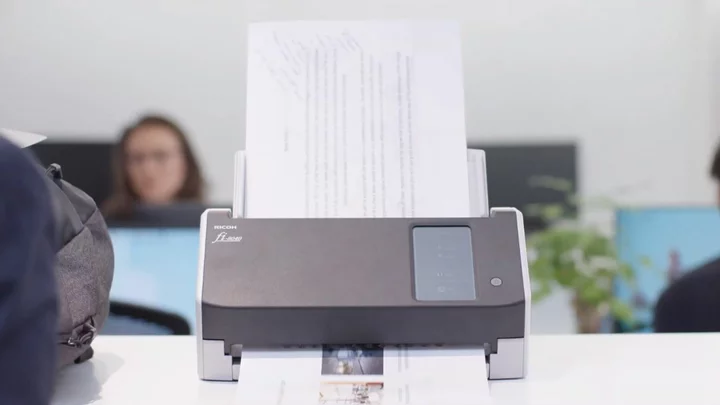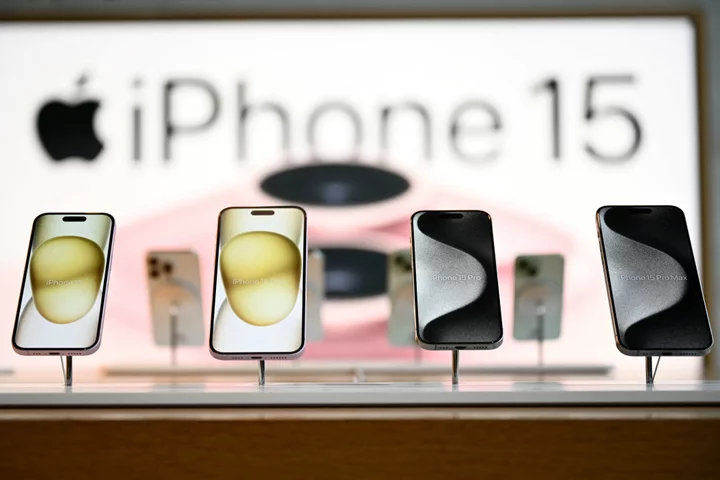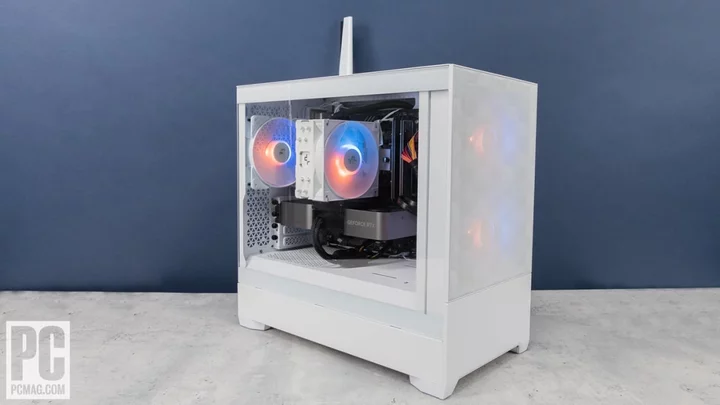The Ricoh fi-8040 ($655) is the new entry-level model in Ricoh’s fi-8000 series of desktop document scanners. Compared with the other scanners in the fi-8000 series lineup, the fi-8040 is the least-expensive model, though it also has the slowest scan speeds and the smallest-capacity automatic document feeder (ADF). It's an excellent pick for those who need an inexpensive way to buy into the powerful software capabilities of the fi-8000 series, but it's not the only way. If cost isn’t an issue, you may prefer the Fujitsu fi-8170, which has faster speeds and a larger ADF, along with the same software. And if cost is more important than advanced document archiving features, the Fujitsu ScanSnap iX1600 is a less-expensive option than the fi-8040, but has similar scan speeds and a same-size ADF. (We'll discuss the complex relationship between the Ricoh and Fujitsu brands in a moment.)
The Design: Same, Only Different
The Ricoh fi-8040, which is frequently available online for around $100 less than its MSRP, replaces the Fujitsu fi-7030, which is the entry-level model for the Fujitsu fi-7000 series of scanners. The fi-8040 has faster scan speeds than the fi-7030, as well as a higher expected daily volume (a bump up from 4,000 sheets to 6,000 sheets).
All of the models mentioned above can automatically feed in documents as large as 8.5 by 14 inches. That includes letter, legal, and A4 paper sizes. All of them can scan items as small as 2 by 2 inches. All are equipped to handle paper documents, receipts, business cards, and even plastic cards that are 0.76mm or less in thickness. All have an optical resolution of 600dpi. And all of them can automatically scan two-sided documents.
(Credit: Ricoh)While these models are quite similar, there are significant differences in their scan speeds and ADF capacities. The Ricoh fi-8040 has rated speeds of 40 simplex (one-sided) pages per minute (ppm) and 80 two-sided (duplex) images per minute (ipm, where each page side is counted as an image). The model it is replacing, the Fujitsu fi-7030, is rated at a slower 27ppm and 54ipm. The more-expensive Fujitsu fi-8170 is rated at a faster 70ppm and 140ipm. And the less-expensive Fujitsu ScanSnap iX1600 has the same rated 40ppm and 80ipm speeds as the Ricoh fi-8040. The fi-8040, fi-7030, and ScanSnap iX1600 have a 50-sheet ADF, while the fi-8170 has a 100-sheet ADF.
There’s also some variation in these models’ sizes and weights, as well as their connection options (USB, Wi-Fi, or Ethernet) and user interface. We'll discuss some of those differences in more detail below.
It’s worth noting first that Fujitsu and Ricoh are actually part of the same company, which is rebranding all Fujitsu image scanners (including ScanSnap, fi-series, and SP-series models) as Ricoh image scanners, a process that started in April. As a result, you may find various ScanSnap, fi-series, and SP-series models with either of the company names. The same software applications will also appear across both companies.
Setup: Leave Room to Stretch
At 5.6 by 11.5 by 6.2 inches (HWD) and weighing in at 6.8 pounds, the Ricoh fi-8040 is relatively compact for a desktop document scanner, though it's slightly larger and heavier than the model it replaces. The Fujitsu fi-7030 measures 5.1 by 11.4 by 5.7 inches (HWD) and weighs 6.4 pounds. By comparison, the Fujitsu fi-8170 is noticeably larger at 6.4 by 11.8 by 6.7 inches (HWD). It weighs 8.8 pounds. And the Fujitsu ScanSnap iX1600 is only a tiny bit larger than the fi-8040. It measures 6.0 by 11.5 by 6.3 inches (HWD) and weighs 7.5 pounds.
(Credit: Ricoh)Keep in mind that all of these models will take up additional desk space when you extend the paper tray outward to catch the scanned documents. Unlike the Fujitsu Image Scanner fi-800R, which has a space-saving "U-Turn Scan" feed mechanism, typical sheetfed scanners can see their depth dimension grow by as much as three or four times when the trays are extended upward and outward for handling full-size documents. Accordingly, you may want to open up the unit fully when placing it on a desk or tabletop, as it will likely need all that available space at some point.
The other distinguishing feature on the Ricoh fi-8040 is its bright 4.3-inch color touch screen. It’s similar in size and function to the touch screen on the ScanSnap iX1600. By contrast, the Fujitsu fi-7030 doesn’t have any kind of screen. And the Fujitsu fi-8170 has a small view-only LCD screen.
Using the touch screen on the fi-8040, you’ll be able to preview your scans as thumbnails. You’ll then be able to save the scans to specific folders on your computer or attach them to outgoing email messages. And unlike the previous-generation fi-7030, the fi-8040 can function as a standalone unit, allowing you to save a scan to a network drive or attach a scan to an email—without involving a computer. The Fujitsu fi-8170 has the same standalone capabilities, which the company refers to as DirectScan.
You can connect the fi-8040 to your computer via USB 3.2, USB 2.0, or Ethernet cable. For standalone use on a network, the fi-8040 will need to be connected via Ethernet, as this model doesn’t support Wi-Fi. The Fujitsu fi-8170 has an identical set of connection options. The previous fi-7030 has USB 2.0 support, but no Ethernet or Wi-Fi. And the ScanSnap iX1600 offers Wi-Fi, USB 3.2, and USB 2.0 connections, but no Ethernet.
Testing the Ricoh fi-8040: One-Button Operation
The touch-screen interface does an excellent job of keeping things simple for novices. It’s essentially a large scan button with a smaller side option to switch between continuous multiple-sheet scanning or manual single-sheet scanning. There’s also a small Settings button that will let you gain back some of the control you'd have if you connected a computer.
(Credit: Ricoh)If you have no connected computer, but only a network-based Ethernet connection, you can use the onboard settings button for some limited configuration options. You can add or select a network-accessible folder as a destination for your saved scans. You can add or select an email address for attaching your scans to an email message. And you can add or select from as many as 25 onboard job profiles. A job profile might, for example, route your scanned receipts to a network folder that’s reserved especially for receiving and managing your receipts.
If you’re concerned about security, especially when using the standalone mode, the fi-8040 does support encrypted network communications, a feature that can be turned on or off. If you turn it on, you'll want to change the encryption password as soon as possible, since the default is a cringeworthy “password.”
The fi-8040 is able to perform an impressive amount of image processing. Many of the image-processing features are implemented automatically behind the scenes. The scanner can determine the size of the document, rotate a scanned image appropriately, straighten out skewed documents, detect and remove blank pages, remove punch holes, and seamlessly handle documents that need to be saved both as archived images and OCR-compatible PDFs. It’s also able to detect barcodes and remove vertical streaks. The fi-8040 has the same powerful PageStream software applications that are included with the previously reviewed Fujitsu fi-8170 and Fujitsu fi-8270.
Setting up the fi-8040 for use with a computer was simple and straightforward. You’ll need to unpack the unit, remove the tape that secures the scanner for shipping, and remove the protective paper from inside the unit. You’ll also need to attach the ADF paper chute to the top of the scanner. A USB 2.0 cable is provided, as well as an installation DVD-ROM disc.
(Credit: Ricoh)After booting up the DVD-ROM disc, I was given the option to download and install newer versions of the software and drivers, essentially bypassing the installation from the disc. Ricoh should consider updating the Getting Started guide with a link to directly download the installation files, as opposed to requiring a DVD disc drive to set up the scanner. Most PCs these days don’t have (or need) an optical drive, so it’s well past time to remove the disc drive step from the scanner installation process.
The Software: Plenty of Options
Following the software installation, you’ll have two main applications: PaperStream Capture and PaperStream ClickScan. A PaperStream Capture User’s Guide is also placed onto the Windows desktop. In addition, you’ll have a large collection of utilities and help guides that are accessible from the startup menu. They include a Gamma Pattern Editor, IP Address Setting Tool, Scanner Profile Importer (TWAIN), Network Setup Tool browser link, and PaperStream IP Help (TWAIN) browser link. Most users can ignore those utilities and help guides.
(Credit: Ricoh)The PaperStream Capture application provides a quick-and-easy way to initiate a scan. The opening screen features four large buttons for the basic scanner functions: Black and White, Color, Auto Color, and One Push Scan. There’s also a smaller Switch Modes button. It opens up the interface for more customization. From that alternate mode, you’ll be able to rotate a scan, zoom in or out, or bring up a scan settings window.
If you think you’ll be using the same settings repeatedly for recurring types of documents, you’ll want to check out the option to create custom profiles. Profiles can specify a target location, the naming rules for your saved scans, how metadata are treated, or how a document would be divided. If you’re worried that your fellow employees might clutter up the PaperStream Capture interface by creating profiles for everything under the sun, you can use the PaperStream Capture Administrator Tool to limit the number of profiles within a range of 10 to 500.
You can also initiate a scan from the PaperStream ClickScan application. The visual layout of its opening screen shows the current configuration and allows for quick changes before you begin the scan. Six large icons here are labeled as Image Mode, Resolution, Paper Size, Paper Source, Continuous Scan, and File Format. Each of the buttons has a pull-down menu that shows the various options available for that particular parameter, with the current option shown more prominently.
(Credit: Ricoh)There’s also an Advanced Settings button on the PaperStream ClickScan home screen that opens up the parameters to many more settings and options. There you can fine-tune the scanning process to an impressive degree. For example, you can turn barcode scanning on or off. You can turn on a digital endorser that embeds visual tracking info onto your scanned documents. You can adjust the amount of compression that will be applied to any JPG file saves. And you can switch on Automatic Profile Selection, which will attempt to determine the style and format of a document and apply an appropriate profile automatically.
Scan Results: Steady and Accurate
Ricoh rates the scan speeds for the fi-8040 as 40ppm simplex and 80ipm duplex. Our tests showed that the fi-8040 can do a little bit better than that. I tested the scanner using PaperStream ClickScan over a USB connection to our Intel Core i5 testbed PC running Windows 10 Pro. The fi-8040 scanned our 25-page single-sided document at 43.2ppm and our 25-page (50-image) double-sided document at 85.1ipm. The less-expensive Fujitsu ScanSnap iX1600 had similar results, at 41.2ppm and 85.7ipm. And the pricier Fujitsu fi-8170 predictably came in much faster, at 72.9ppm and 176.2ipm.
The fi-8040 showed similar results when scanning to searchable-PDF files that are OCR-compatible. It completed our 50-page double-sided document in 35.1 seconds. It scanned at essentially the same speed whether it was saving pages as image PDFs or searchable PDFs. Meanwhile, the Fujitsu fi-8170 was able to scan our 50-page double-sided document in just 25 seconds.
Even though the scan speeds for the fi-8040 lag behind the other fi-8000 series models, its OCR accuracy is fully competitive. The fi-8040 had error-free results at sizes down to 5 points in both our serif (Times New Roman) and sans-serif (Arial) font tests. That matches the test results for the Fujitsu fi-8170. Both models are among the most accurate document scanners that we've tested recently. And that’s especially impressive for the fi-8040, given its much lower price.
I experienced no difficulties when scanning a wide range of documents with the fi-8040. It did a superb job of correcting for skewed documents. It handled business cards and plastic cards without pause or error. And it automatically rotated all the addressed envelopes that I ran through it.
Verdict: Could Be a Perfect Fit
The Ricoh fi-8040 offers archival-quality software and accurate OCR scanning at the lowest price for any of the fi-8000 series scanners. For that lower price, you’ll also have to settle for slower scan speeds and a modest-capacity ADF, compared with the other 8000-series models. If you don’t do a lot of scanning, but you do need the archival-quality software and outstanding OCR accuracy, then the fi-8040 could have just the right between cost and capabilities.
On the other hand, the more-expensive Fujitsu fi-8170 may be a better hardware match for this professional level of software. The fi-8170 is our Editors’ Choice pick for heavy-duty document archiving. And if you’re not really interested in the 8000-series software and you don’t need the Ethernet connectivity, you might consider the less-expensive Fujitsu ScanSnap iX1600. It has similar hardware specs and OCR accuracy to the fi-8040, and it remains our our Editors’ Choice pick for best desktop document scanner for most users.









